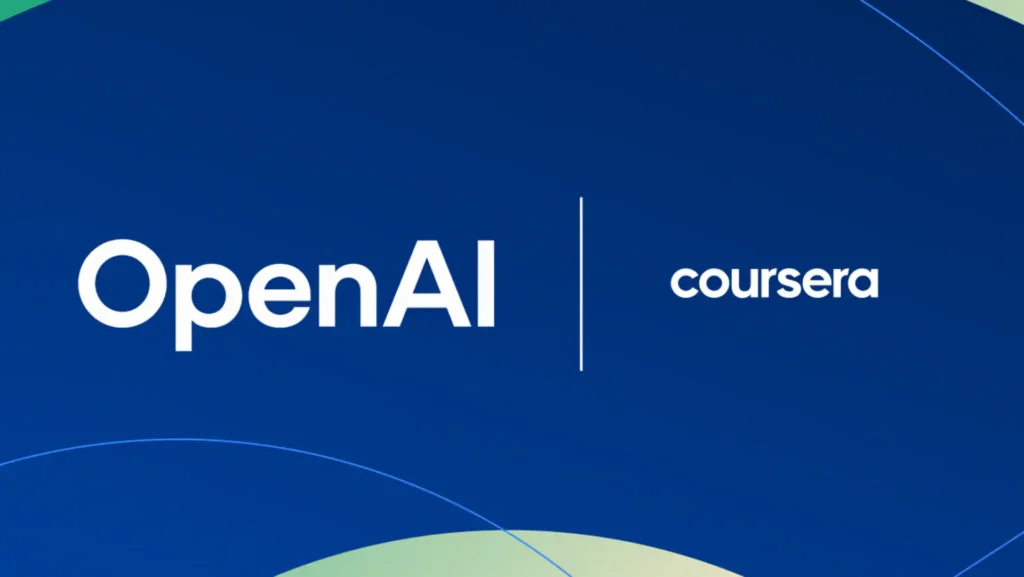In a move that could reshape how people consume educational content, Coursera has announced a partnership with OpenAI, making it one of the inaugural applications embedded within ChatGPT. The announcement, revealed at OpenAI’s DevDay event, signals a fresh push to blur the lines between conversational AI and structured digital learning.
Through this agreement, learners — whether on ChatGPT Free, Go, Plus, or Pro plans — can now directly access Coursera videos, course outlines, and related educational content inside the ChatGPT interface. All a user has to do is ask ChatGPT to “open Coursera,” and the system will pull up relevant materials seamlessly. Over time, ChatGPT will also proactively suggest the Coursera app when contextually relevant to a user’s query.
Greg Hart, Coursera’s CEO, said the move underlines both companies’ “shared commitment to expanding access to education,” noting that by embedding vetted learning materials in ChatGPT, they aim to support learners everywhere in “pursuing economic opportunity and preparing for tomorrow’s jobs.” Leah Belsky, Vice President of Education at OpenAI, added that real power lies in combining AI capabilities with human expertise — bringing trusted, institution-based content into an interface many are already using.
This integration is notable not just for its technical ambition but for its symbolic significance: it is possibly the first time a full-fledged online learning platform is woven into a conversational AI environment. The implications, particularly for learners in Nigeria and across Africa, could be expansive.

Table of Contents
Why this matters for learners in Nigeria
For many in Nigeria, finding quality, up-to-date educational content — especially in niche or emerging fields — can be difficult. Coursera’s move into ChatGPT may lower one barrier: accessibility. Instead of switching between screens or platforms, students, professionals, or lifelong learners can request what they want and get integrated lessons, video clips, or course suggestions within the conversational flow.
This is especially useful for those with constrained bandwidth or devices. The ability to surface short clips, summaries, or key course modules inside ChatGPT means less heavy downloading and fewer app transitions. In contexts where switching between apps or managing bandwidth is a challenge, that frictionless integration can make a tangible difference.
Secondly, because ChatGPT will also recommend the Coursera app when relevant, users might discover courses they didn’t know existed. That could help bridge gaps in knowledge and skill acquisition, especially in fast-changing fields like AI, data science, or digital entrepreneurship — areas many Nigerians are keen to pursue.
On the flip side, there are questions. How well will Coursera’s full courses translate into ChatGPT’s UI constraints? Will the app integration support the full range of interactive assignments, peer reviews, quizzes, and community discussions, or will it be limited to videos and summaries initially? For users in Nigeria, limitations in internet speed or data pricing may still constrain how deeply the integration is experienced.
Strengths, challenges and wider implications
Strengths
- Seamless user experience: Embedding Coursera inside ChatGPT removes the friction of jumping between apps or platforms.
- Discovery by context: Because ChatGPT will suggest Coursera when it deems it helpful, users may stumble on learning opportunities they weren’t consciously looking for.
- Credibility and trust: Coursera’s partnerships with top universities and institutions give its content legitimacy. Embedding that content inside ChatGPT helps counter the challenge of misinformation in AI responses.
- Scalability: Once the integration infrastructure is solid, extending this model to additional languages, local region content, or partner institutions becomes easier.

Challenges
- Content depth and format trade-offs: Some course components (hands-on labs, peer reviews, interactive simulations) may not translate easily into a chatbot interface.
- Data and access constraints: In regions with unstable internet or expensive data, streaming video or loading heavy content could still be prohibitive.
- Monetisation and access: How much of Coursera’s paid content will be surfaced inside ChatGPT? Will users be prompted to pay more, or will only free/preview material be available?
- Platform dependency and control: Reliance on OpenAI’s ecosystem could reduce Coursera’s direct control of UI, updates, and user experience over time.
In the broader education technology landscape, this move may prompt other learning platforms to seek similar embedment into conversational AI systems. It signals a shift: AI assistants are no longer just knowledge sources — they’re becoming portals into structured learning ecosystems.
What to watch next
For learners, educators, and edtech watchers in Nigeria and beyond, a few things will be crucial to monitor:
- Breadth of integration: Will Coursera’s full catalogue (including specialisations, certificates, and degree-level content) be accessible, or will the embedded version be limited?
- Localisation: Will the embedded Coursera content adapt for different regions — e.g. language, relevance, cost adjustments for Nigeria?
- Usability in low-connectivity settings: How well will the system handle bufferless video, low bandwidth, or asynchronous access?
- Cost and payment models: How much of Coursera’s paid content will be accessible via ChatGPT, and what new payment or incentive models will emerge?
- Competitor reactions: Will Udemy, edX, FutureLearn, or other platforms seek their own embedding into conversational AI?
For Nigeria, this could mean new pathways for upskilling, especially for those who cannot afford premium internet plans or who prefer conversational interfaces. It may usher in a wave of blended learning, where AI assistants, rather than traditional LMS or course platforms, become the first point of contact for learners.

Conclusion
The embedding of Coursera into ChatGPT represents a bold gambit in edtech — merging the conversational AI world and formal learning content. For learners in Nigeria, this holds promise: greater convenience, more discovery, and potentially lower barriers to high-quality education. But the success of this model will depend on how well it adapts to local constraints, supports robust learning modalities, and keeps quality uncompromised.
Join Our Social Media Channels:
WhatsApp: NaijaEyes
Facebook: NaijaEyes
Twitter: NaijaEyes
Instagram: NaijaEyes
TikTok: NaijaEyes





